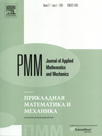 | | Journal of Applied
Mathematics and Mechanics
Russian Academy of Sciences | | Founded
in January 1936
(Translated from 1958)
Issued 6 times a year
ISSN 0021-8928
(print version) |
Archive of Issues
| Total articles in the database: | | 10610 |
| In Russian (ΟΜΜ): | | 9811
|
| In English (J. Appl. Math. Mech.): | | 799 |
|
| << Previous article | Volume 72, Issue 3 / 2008 | Next article >> |
| P.M. Belotserkovskii and L.V. Pugina, "The rolling of a wheel along a corrugated rail," J. Appl. Math. Mech. 72 (3), 288-295 (2008) |
| Year |
2008 |
Volume |
72 |
Issue |
3 |
Pages |
288-295 |
| Title |
The rolling of a wheel along a corrugated rail |
| Author(s) |
P.M. Belotserkovskii (Moscow, Russia, belotserk1936@rambler.ru)
L.V. Pugina (Moscow, Russia) |
| Abstract |
The rolling without detachment of a rigid massive wheel, carrying a static load, along a rail with undulations on the running surface, which arises as a result of non-uniform wear, is investigated. The rail is supported by an elastoviscous base. Because of the inertia of the wheel and the carriage the horizontal component of the velocity of the wheel centre differs only slightly from a constant quantity, and hence the motion of the wheel along the rail is assumed to be uniform. Steady vertical vibration of the wheel is considered. The vertical coordinate of the wheel centre, and also the difference between the longitudinal coordinates of the wheel centre and the point of contact of the wheel and the rail, are periodic and, correspondingly, even and odd functions of the longitudinal coordinate of the wheel centre, and their period is equal to the wave length on the rail surface. The periodic force of interaction of the wheel and the rail is given in the form of a Fourier series. Short waves, the amplitude of which is much less than their length, are often observed on the rail surface, and this length is much less than the wheel radius. In this case the coefficients of the Fourier series are expressed in terms of Bessel functions of the first kind of integer order. Observations show that the depth of the short wave on the rail surface increases until the radius of curvature in the rail trough approximates to the wheel radius, and hence it is assumed that these radii are close to or equal to one another. In this case the trajectory of the wheel centre differs considerably from the wave on the rail surface. |
| Received |
25 April 2006 |
| Link to Fulltext |
|
| << Previous article | Volume 72, Issue 3 / 2008 | Next article >> |
|
 If you find a misprint on a webpage, please help us correct it promptly - just highlight and press Ctrl+Enter If you find a misprint on a webpage, please help us correct it promptly - just highlight and press Ctrl+Enter
|
|

 Russian
Russian  English
English